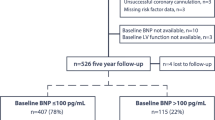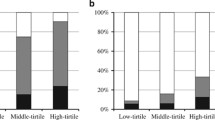Abstract
Background
There is continuous debate to the use of biomarkers in the general practitioners office and to what degree the established biomarkers N-terminal pro-B-type natriuretic peptide (NT-pro-BNP) and high-sensitive C-reactive protein (hs-CRP) might contribute to improved prediction of incident cardiovascular events.
Objective
To evaluate the utility and 5-year predictive value of a single measurement of NT-pro-BNP and hs-CRP for incident cardiovascular events, and its added value beyond the contribution of conventional risk factors in primary care.
Methods
Five year prospective longitudinal clinical epidemiological study in a nationwide sample of 4,775 primary care subjects (mean age 55.8 years, 62 % women) without coronary artery disease at baseline. Main outcome measures were incident major cardiovascular events and all-cause death.
Results
During the 5 years of follow-up, 188 subjects (3.9 %) died or experienced a first major cardiovascular event. The addition of NT-pro-BNP, but not of hs-CRP to a prediction model with established cardiovascular risk factors improved the prediction of major cardiovascular events (increase in C statistic by 0.009; p = 0.008), and was associated with a significant improvement in net reclassification improvement (NRI = 23.6 %; p = 0.003).
Conclusion
In a primary care setting, one single measurement of NT-pro-BNP, but not of hs-CRP significantly improves the prediction of incident cardiovascular events.


Similar content being viewed by others

References
Greenland P, Knoll MD, Stamler J, Neaton JD, Dyer AR, Garside DB, Wilson PW (2003) Major risk factors as antecedents of fatal and nonfatal coronary heart disease events. JAMA 290(7):891–897. doi:10.1001/jama.290.7.891
Khot UN, Khot MB, Bajzer CT, Sapp SK, Ohman EM, Brener SJ, Ellis SG, Lincoff AM, Topol EJ (2003) Prevalence of conventional risk factors in patients with coronary heart disease. JAMA 290(7):898–904. doi:10.1001/jama.290.7.898
Hansson GK (2005) Inflammation, atherosclerosis, and coronary artery disease. N Engl J Med 352(16):1685–1695. doi:10.1056/NEJMra043430
Ridker PM, Brown NJ, Vaughan DE, Harrison DG, Mehta JL (2004) Established and emerging plasma biomarkers in the prediction of first atherothrombotic events. Circulation 109(25 Suppl 1):6–19. doi:10.1161/01.CIR.0000133444.17867.56
Wang TJ, Gona P, Larson MG, Tofler GH, Levy D, Newton-Cheh C, Jacques PF, Rifai N, Selhub J, Robins SJ, Benjamin EJ, D’Agostino RB, Vasan RS (2006) Multiple biomarkers for the prediction of first major cardiovascular events and death. N Engl J Med 355(25):2631–2639. doi:10.1056/NEJMoa055373
Melander O, Newton-Cheh C, Almgren P, Hedblad B, Berglund G, Engstrom G, Persson M, Smith JG, Magnusson M, Christensson A, Struck J, Morgenthaler NG, Bergmann A, Pencina MJ, Wang TJ (2009) Novel and conventional biomarkers for prediction of incident cardiovascular events in the community. JAMA 302(1):49–57. doi:10.1001/jama.2009.943
Blankenberg S, Zeller T, Saarela O, Havulinna AS, Kee F, Tunstall-Pedoe H, Kuulasmaa K, Yarnell J, Schnabel RB, Wild PS, Munzel TF, Lackner KJ, Tiret L, Evans A, Salomaa V (2010) Contribution of 30 biomarkers to 10-year cardiovascular risk estimation in 2 population cohorts: the MONICA, risk, genetics, archiving, and monograph (MORGAM) biomarker project. Circulation 121(22):2388–2397. doi:10.1161/CIRCULATIONAHA.109.901413
Ridker PM, Buring JE, Rifai N, Cook NR (2007) Development and validation of improved algorithms for the assessment of global cardiovascular risk in women: the Reynolds risk score. JAMA 297(6):611–619. doi:10.1001/jama.297.6.611
Zethelius B, Berglund L, Sundstrom J, Ingelsson E, Basu S, Larsson A, Venge P, Arnlov J (2008) Use of multiple biomarkers to improve the prediction of death from cardiovascular causes. N Engl J Med 358(20):2107–2116. doi:10.1056/NEJMoa0707064
Simon T, Becker R, Voss F, Bikou O, Hauck M, Licka M, Katus HA, Bauer A (2008) Elevated B-type natriuretic peptide levels in patients with nonischemic cardiomyopathy predict occurrence of arrhythmic events. Clin Res Cardiol 97(5):306–309. doi:10.1007/s00392-007-0629-2
Tang WH, Shrestha K, Van Lente F, Troughton RW, Martin MG, Borowski AG, Jasper S, Klein AL (2008) Usefulness of C-reactive protein and left ventricular diastolic performance for prognosis in patients with left ventricular systolic heart failure. Am J Cardiol 101(3):370–373. doi:10.1016/j.amjcard.2007.08.038
Weber M, Kleine C, Keil E, Rau M, Berkowitsch A, Elsaesser A, Mitrovic V, Hamm C (2006) Release pattern of N-terminal pro B-type natriuretic peptide (NT-proBNP) in acute coronary syndromes. Clin Res Cardiol 95(5):270–280. doi:10.1007/s00392-006-0375-x
Meisinger C, Heier M, von Scheidt W, Kuch B (2010) Admission C-reactive protein and short- as well as long-term mortality in diabetic versus non-diabetic patients with incident myocardial infarction. Clin Res Cardiol 99(12):817–823. doi:10.1007/s00392-010-0193-z
Pfister R, Wahlers T, Baer FM, Scherner M, Strauch J, Erdmann E (2010) Utility of NT-pro-BNP in patients undergoing transapical aortic valve replacement. Clin Res Cardiol 99(5):301–307. doi:10.1007/s00392-010-0118-x
Wittchen HU, Glaesmer H, Marz W, Stalla G, Lehnert H, Zeiher AM, Silber S, Koch U, Bohler S, Pittrow D, Ruf G (2005) Cardiovascular risk factors in primary care: methods and baseline prevalence rates—the DETECT program. Curr Med Res Opin 21(4):619–630. doi:10.1185/030079905X38187
Pearson TA, Blair SN, Daniels SR, Eckel RH, Fair JM, Fortmann SP, Franklin BA, Goldstein LB, Goldstein LB, Greenland P, Grundy SM, Hong Y, Miller NH, Lauer RM, Ockene IS, Sacco RL, Sallis JF Jr, Smith SC Jr, Stone NJ, Taubert KA (2002) AHA Guidelines for Primary Prevention of Cardiovascular Disease and Stroke: 2002 Update: Consensus Panel Guide to Comprehensive Risk Reduction for Adult Patients Without Coronary or Other Atherosclerotic Vascular Diseases. American Heart Association Science Advisory and Coordinating Committee. Circulation 106(3):388–391
National Cholesterol Education Program (NCEP) (2002) Third Report of the National Cholesterol Education Program (NCEP) Expert Panel on Detection, Evaluation, and Treatment of High Blood Cholesterol in Adults (Adult Treatment Panel III) final report. Circulation 106(25):3143–3421
American Diabetes Association (2003) Report of the expert committee on the diagnosis and classification of diabetes mellitus. Diabetes Care 26(Suppl 1):S5–20
Yusuf S, Sleight P, Pogue J, Bosch J, Davies R, Dagenais G (2000) Effects of an angiotensin-converting-enzyme inhibitor, ramipril, on cardiovascular events in high-risk patients. The heart outcomes prevention evaluation study investigators. N Engl J Med 342(3):145–153. doi:10.1056/NEJM200001203420301
Klotsche J, Ferger D, Pieper L, Rehm J, Wittchen HU (2009) A novel nonparametric approach for estimating cut-offs in continuous risk indicators with application to diabetes epidemiology. BMC Med Res Methodol 9:63. doi:10.1186/1471-2288-9-63
Pencina MJ, D’Agostino RB Sr, D’Agostino RB Jr, Vasan RS (2008) Evaluating the added predictive ability of a new marker: from area under the ROC curve to reclassification and beyond. Stat Med 27(2):157–172. doi:10.1002/sim.2929 discussion 207–112
Harrell FE Jr, Califf RM, Pryor DB, Lee KL, Rosati RA (1982) Evaluating the yield of medical tests. JAMA 247(18):2543–2546
Pencina MJ, D’Agostino RB (2004) Overall C as a measure of discrimination in survival analysis: model specific population value and confidence interval estimation. Stat Med 23(13):2109–2123. doi:10.1002/sim.1802
Wang TJ, Larson MG, Levy D, Benjamin EJ, Leip EP, Omland T, Wolf PA, Vasan RS (2004) Plasma natriuretic peptide levels and the risk of cardiovascular events and death. N Engl J Med 350(7):655–663. doi:10.1056/NEJMoa031994
Ridker PM, Glynn RJ, Hennekens CH (1998) C-reactive protein adds to the predictive value of total and HDL cholesterol in determining risk of first myocardial infarction. Circulation 97(20):2007–2011
Manjer J, Carlsson S, Elmstahl S, Gullberg B, Janzon L, Lindstrom M, Mattisson I, Berglund G (2001) The Malmo Diet and Cancer Study: representativity, cancer incidence and mortality in participants and non-participants. Eur J Cancer Prev 10(6):489–499
Olsen MH, Hansen TW, Christensen MK, Gustafsson F, Rasmussen S, Wachtell K, Ibsen H, Torp-Pedersen C, Hildebrandt PR (2007) N-terminal pro-brain natriuretic peptide, but not high sensitivity C-reactive protein, improves cardiovascular risk prediction in the general population. Eur Heart J 28(11):1374–1381. doi:10.1093/eurheartj/ehl448
Wannamethee SG, Welsh P, Lowe GD, Gudnason V, Di Angelantonio E, Lennon L, Rumley A, Whincup PH, Sattar N (2011) N-terminal pro-brain natriuretic Peptide is a more useful predictor of cardiovascular disease risk than C-reactive protein in older men with and without pre-existing cardiovascular disease. J Am Coll Cardiol 58(1):56–64. doi:10.1016/j.jacc.2011.02.041
Blankenberg S, McQueen MJ, Smieja M, Pogue J, Balion C, Lonn E, Rupprecht HJ, Bickel C, Tiret L, Cambien F, Gerstein H, Munzel T, Yusuf S (2006) Comparative impact of multiple biomarkers and N-Terminal pro-brain natriuretic peptide in the context of conventional risk factors for the prediction of recurrent cardiovascular events in the Heart Outcomes Prevention Evaluation (HOPE) Study. Circulation 114(3):201–208. doi:10.1161/CIRCULATIONAHA.105.590927
Ridker PM, Danielson E, Fonseca FA, Genest J, Gotto AM Jr, Kastelein JJ, Koenig W, Libby P, Lorenzatti AJ, MacFadyen JG, Nordestgaard BG, Shepherd J, Willerson JT, Glynn RJ (2008) Rosuvastatin to prevent vascular events in men and women with elevated C-reactive protein. N Engl J Med 359(21):2195–2207. doi:10.1056/NEJMoa0807646
Bohm M, Voors AA, Ketelslegers JM, Schirmer SH, Turgonyi E, Bramlage P, Zannad F (2011) Biomarkers: optimizing treatment guidance in heart failure. Clin Res Cardiol 100(11):973–981. doi:10.1007/s00392-011-0341-0
McKie PM, Cataliotti A, Lahr BD, Martin FL, Redfield MM, Bailey KR, Rodeheffer RJ, Burnett JC Jr (2010) The prognostic value of N-terminal pro-B-type natriuretic peptide for death and cardiovascular events in healthy normal and stage A/B heart failure subjects. J Am Coll Cardiol 55(19):2140–2147. doi:10.1016/j.jacc.2010.01.031
Grundy SM (2005) The changing face of cardiovascular risk. J Am Coll Cardiol 46(1):173–175. doi:10.1016/j.jacc.2005.05.007
Dzau VJ, Antman EM, Black HR, Hayes DL, Manson JE, Plutzky J, Popma JJ, Stevenson W (2006) The cardiovascular disease continuum validated: clinical evidence of improved patient outcomes: part II: clinical trial evidence (acute coronary syndromes through renal disease) and future directions. Circulation 114(25):2871–2891. doi:10.1161/CIRCULATIONAHA.106.655761
Acknowledgments
All authors have carefully read and approved the manuscript in its present form. None of the authors have any conflict of interest pertaining to the data presented, or have published or submitted any related papers from the same study. DETECT (Diabetes Cardiovascular Risk-Evaluation: Targets and Essential Data for Commitment of Treatment) is a cross-sectional and prospective-longitudinal, nationwide clinical epidemiological study. DETECT is supported by an unrestricted educational grant of Pfizer GmbH, Karlsruhe, Germany. Members of the DETECT-Study group include: Principal investigator: Professor Dr. H.-U. Wittchen; Staff members: Dipl.-Psych. L. Pieper, Dipl.-Math. J. Klotsche, Dr. T. Eichler, Dr. H. Glaesmer, E. Katze. Steering Committee: Professor Dr. H. Lehnert (Lübeck), Professor Dr. G. K. Stalla (München), Professor Dr. A. M. Zeiher (Frankfurt); Advisory Board: Professor Dr. W. März (Heidelberg/Graz), Professor Dr. S. Silber (München), Professor Dr. Dr. U. Koch (Hamburg), Priv.-Doz. Dr. D. Pittrow (München/Dresden), Professor Dr. M. Wehling (Mannheim), Dr. D. Leistner (Frankfurt), Dr. H. J. Schneider (München), Dr. C. Sievers (München).
Author information
Authors and Affiliations
Corresponding author
Electronic supplementary material
Below is the link to the electronic supplementary material.
Rights and permissions
About this article
Cite this article
Leistner, D.M., Klotsche, J., Pieper, L. et al. Prognostic value of NT-pro-BNP and hs-CRP for risk stratification in primary care: results from the population-based DETECT study. Clin Res Cardiol 102, 259–268 (2013). https://doi.org/10.1007/s00392-012-0530-5
Received:
Accepted:
Published:
Issue Date:
DOI: https://doi.org/10.1007/s00392-012-0530-5



